最新lesson20完成名师制作教案
- 格式:ppt
- 大小:251.00 KB
- 文档页数:12

九年级英语上学期Lesson 20教案(通用15篇)九年级英语上学期Lesson 20 篇1Lesson 14Language Focus:more than two years, practise speaking English, the Greens, none of the them, keep doing something, fall fast asleep /awake, wake up, last longProperties: Recorder; Overhead Projector; Pictures.Teaching Procedures:I. Showing aimsHave the students know what they will learn in this lesson and what they will do in this class:1. Master some useful expressions.2. Read the passage “Jim’s Train Ride” carefully to improve their reading ability.3. Know something about Mount Emei and some other mounts in China.II. Revision1. Check homework.2. Revise the Object Clause. Play games “Kate says…” Have the students do in groups of three.K: Nancy is not here yet.T: She will be here soon.Y: Nancy is not here yet. I hope that she will be here soon.K : The weather is cloudy.T : It will clear up soon.Y: The weather is cloudy. I hope that it will clear up soon.K: There is a lot of food.T: You can eat more.Y: There is a lot of food. I hope that you can eat more.K: The park is crowded.T: There are enough tables and benches.Y: The park is crowded. I hope that there are enough tables and benches.III. Pre-readPart 1. In small groups have the students answer the questions. Then discuss the questions in class.Put up a map of China on the blackboard and get the students to show Mount Emei and other mounts such as Mount Hua etc, and talk about some mounts if they know them.IV. PresentationHave the students discuss in groups. Ask: “What will they do if they will go travelling?” A few minutes for them to discuss, then ask some of them to give their reports to share with the class.V. ReadingPart 2. Speech Cassette. Let the students read through the passage to find the answer to the question: How did Jim feel on his trip to Mount Emei? Help the students use these words: happy, exciting, … See if the students can guess the meaning of the new words.Play the tape. Ask the students to listen carefully. The teacher may stop the tape while the students are listening, and ask the students to go on reading. It can test the students' ability to follow the passage as it is read on the tape.Using Exercise I in the workbook of Lesson 14, check the students' reading. The students ask and answer in pairs.VI. ActingDivide the students into small groups. Change this passageinto a play, ask them to act out this play. One of them plays the part of a narrator, the others play Mr Green, Mrs Green, Jim, the conductor, and fruit shop assistant.VII. WorkbookDo Exercise 3 in class. Have the students read the sentences and translate them into Chinese, check with the whole class.For Exercise 2, it can be worked as homework.Answers for Exercise 2: by, enjoyable, by, took, bus, lively, comfortable, watching, scenery, offer, magazines, nearby, practised, trip / journey, tired.VIII. SummaryExercises in classRewrite the following sentences1. She will have a train ride to Hangzhou. ( She says…)2. Class Five will have a football match with Class Six. ( The teacher says…)3. The station is very crowded. ( He said… )4. A young man is speaking in English. ( Jim said… )5. The train is quite comfortable. (Jim thought…)6. There aren’t too man y people in their sleeping car. ( Jim told me…)IX. HomeworkRead the passage after class.Finish off the exercises in the workbook.九年级英语上学期Lesson 20教案篇2Lesson 9Language Focus:Ⅰ. some useful expressions:waste water; Greener China; Good idea; be afraid; a member of; a book on the environmentII. some useful sentences:How long have you been a member of Greener China?I've been with Greener China for a year.How many English words have you learned since you came here?About one thousand.Properties: Pictures:TV; Overhead Projector; RecorderTeaching Procedures:I. Showing aimsGet the students to know what they will learn in this lesson and what they will do in this class:1. To master some useful expressions.2. To learn the grammar: the Present Perfect Tense.3. To make the similar dialogues freely.4. To know that they should protect the environment and make our world more beautiful.II . RevisionRevise the grammar; the Present Perfect Tense. Ask: Have you ever been to the Great Wall? How many times have you been there? Get the students to ask and answer in pairs. Then ask several pairs to act out their dialogues.III. PresentationPresent this dialogue:A: Where have you been?B: I've been to a paper factory.A: What did you do there?B: I saw the worker making paper there.Present this dialogue with one student as an example, then ask the students to practise this dialogue in pairs, and get some of them to act out the dialogue.IV. PracticePut up a picture of a paper factory on the blackboard, get the students to talk about the factory, for example; " This is a paper factory, it makes paper, but it also makes smoke and waste water. I found the smoke was put into the air and the waste water was put into the river near it. The river has become very dirty. Lots of fish have died." Have the students talk in groups of four and then ask some of them to read out their report to share with the whole class.V. Read and sayPart 1. Speech Cassette. Play the tape twice for the students to listen and repeat. Ask the students to read the dialogue in groups of three. Then read for the class. Get the students to read the dialogue individually again and find the answer to the following questions:1. Where has Hu Lan just been to?2. Why has the river near the factory become dirty?3. What has happened to the fish in the river?4. What does Greener China want to do?5. Why are they going to write to the TV station and the newspaper?6. Do you take care of the environment? Why or why not?7. What can you do to improve the environment?VI. Ask and answerRead through the dialogues with the students. Ask and answer in pairs. Then make similar dialogues in pairs using the phrases in the box of the book.VII. WriteGet the students to act as journalists, make an interview. Interview one of their friends. Ask him or her some questionsabout him or her and his or her family members.For example: How long have you been in this school?What subject have you studied?How many friends have you made?What's your fathers job?How long has he been a … ?What has he done since … ?Then get the students write a report, have some students read their reports to share with the whole class.VIII. WorkbookDo Exercise 3 orally with the class. Have the students ask and answer in pairs. Write Exercise 2 in the exercise books.IX. SummaryExercises for classRewrite the following sentences using the Present Perfect Tense:Model: He went to Nanjing two days ago.He has been in Nanjing for two days.1. They began to study English in 2000.2. He became a teacher ten years ago.3. Jim came to China one year ago.4. He joined Greener China one year ago.5. My sister bought this book last week.X. HomeworkTalk something about the environment.九年级英语上学期Lesson 20教案篇3Lesson 19Language Focus:1. Useful expressionscost; the price of the ticket; one- way; round-trip; instructions;at the airport; book2. Could you tell me where we show our tickets?Could you tell me how much it costs to fly to Hainan?Properties: Recorder; Overhead Projector; PicturesTeaching Procedures:Ⅰ. Showing aimsGet the students to know what they will learn in this lesson and what they will do in this class:1. Master some useful expressions2. Use Object Clause freely3. Make up their own dialogues to practice speaking English4. Know something about the instructions for the tripⅡ. RevisionRevise Lesson 18. Get some information about Hainan. See if the students can use the expressions correctly, and see if the students can know Hainan Province.Ⅲ. PresentationPresent a short dialogue with a student as example get the other students to practice.T: Could you tell me how I can get to Hainan?S: Oh, by plane.T: By plane? Could you tell me how much it costs to fly to Hainan?S: Where are you flying from?T: From Beijing.S: The price of a ticket from Beijing to Hainan is 1000 yuan.T: Oh, could you tell me what time the flight is?S: There is a flight at 7:30 in the morning.T: Great. I'd like to book 3 tickets.Have the students practice this dialogue in pairs. Make surethey can make dialogues freely. Get the students to guess the meaning of the words: flight; book.Ⅳ. Read and actPart 1. Speech Casette. Play the tape twice for the students to listen and repent.Note: one-way trip (that is a flight only one place to another.) Round-trip (that is a flight from one place to another, then return.)Ⅴ. PracticePractice the dialogue of Part 1 in pairs. Give the students a few minutes to prepare to act it out. Get two students to act out the dialogue in front of the class.Ⅵ. Ask and answerRead through the instructions with the whole class. Have the students ask and answer in pairs. Then ask the students to write a short passage about the Smiths' trip.Ⅶ. PracticeMake a surrounding of the airport. One student cuts as Mr. Smith. The other one cuts as a woman. Mr. Smith asks the woman for help, make up their own dialogues in pairs, and get some of them to perform their dialogues to share with the whole class.Ⅷ. WorkbookDo Exercise! In pairs. Get the students to talk about the Smith family's trip to Haikou in pairs, with the help of the passage in the text.Discuss Exercise 2 with the whole class. Then make them ask and answer in pairs.Exercises for classWrite a short dialogue about a flight. (at least 8 sentences) For example:A: Could you tell me what time the first flight is from Beijing to Guangzhou?B: At 7:30.A: And can you tell me how much it costs to fly from Beijing to Guangzhou?B: 900 yuan one-way.A: Great! I'd like to book tickets, please.B: Will that be one-way or round-trip?A: Round-trip. We'll return next Monday.B: OK.Ⅸ. HomeworkRead the dialogue again, learn to read the flight timetable, and learn to ask for help.Homework1.Finish the E. In the workbook.2.Try to retell the text in lesson 18.九年级英语上学期Lesson 20教案篇4Lesson 17Language Focus:1. some useful expressionshave a good time; have a family meeting; talk about; go for our holiday; describe to do something; diving; on the island; press; by oneself2. the Object ClauseCould you tell us how long we're going to away?Properties: Recorder: Overhead Projector; Pictures; computer Teaching Procedures:Ⅰ. Showing aimsHave the students know what they will learn in this lesson and what they will do in this class:1. Master some useful expressions.2. Study the Object Clause.3. Make similar dialogues.4. Know something about Hainan and know how to search Internet.Ⅱ. Revision1. Check homework.2. Revise the Object Clause. Play games, have the students work in pairs.T: I often travel with my family.S1: What does she say?S2: She says she often travel with her family.S3: What did she say?S4: She said that she often traveled with her family.Make sure the students can ask and answer correctly.Ⅲ. PresentationTell the students that they'll have a holiday. Get them to discuss how they will spend the holidays. Divide the class into small groups, then ask one student of each group to give their report.Where would you like to go to?Can you describe the place in English?Ⅳ. Read and actPart 1. Speech Cassette. Ask:What are they going to talk about?Where are they going for their holiday?How long are they going to be there?Do they know Hainan well?How will they know it before they go to Hainan?Have the students listen to the tape, try to find the answersto the questions. Check with the whole class. Play the tape again for the students to repeat. Give the students a few minutes to practice the dialogue in pairs. Ask one pair to act it out.Ⅴ. Learn and speakHave the students look at the computer, and ask: Could you tell me how to search the Internet? Find a student who can search the Internet, help him or her answer with: OK, let me tell you. Use the instructions to help. Ask the other students to answer and get them to play the computer. Make sure all of them can say and play.Ⅵ. WorkbookDo Exercise 2 in class. Check the answers in pairs. The answers are: 1. What he is; 2. Where; 3. How many; go to; 4. Who;5. When Sam is;6. Why;7. How long;8. excitingⅦ. Exercise in classWatch the picture, and answer the questions below:Could you tell me something about travel?Who like to travel by plane? Why?Ⅷ. Homework1. Learn to search the Internet. Write down the instructions.2.Try to make up a dialogue after the model in the text.九年级英语上学期Lesson 20教案篇5Lesson 6课型:阅读课课时:2ⅠTeaching MaterialsWords: describe, especially, attract, so-called, possible, since, part-time, although, fit, prize, competition, event, Olympic, Waikiki, Honolulu, San FranciscoPhrases: all over, large numbers of, no matter, both…and…,give up, ever since, the Olympic GamesSentences: Now it is enjoyed by people all over the world.You can always find surfers out riding the waves.In the morning, he works as a part-time assistant in a surf shop.ⅡTeaching Objectives1. Try to understand the whole passage and read the whole lesson fluently and the pronunciation and intonation should be right.2. Master the following materials:4Ss Words: describe, especially, attract, so-called, possible, since, part-time, although, fit, prize, competition, event, Olympic Phrases: all over, large numbers of, no matter, both…and…, give up, ever since, the Olympic GamesSentences: Now it is enjoyed by people all over the world.You can always find surfers out riding the waves.In the morning, he works as a part-time assistant in a surf shop.3. Master the following materials:3Ss Words: Waikiki, Honolulu, San FranciscoⅢ Teaching Points1. The main points: (1) &(2) in teaching objectives2. The difficu lt points: A. the use of “although”B. the use of “no matter”C. the use of “ both…and…”Ⅳ Teaching ProcedurePeriod 11. Organization of the classTalk about surfing2. ReviewHave you ever been to Qingdao?Who has ever been to Bondi Beach? None of us.Has anybody water-skied before? Nobody has.3. The teaching of the new lessonA. Lesson 6In Lesson 5, we learned some water sports. Today, we are going to talk about one of them----surfing.B. Talk about surfingWhere is the best place for surfing? Why?Have you ever watched people surf?What do you think of it?Ask the students to say something about it.Teach: fit, prize, competitionSurfing will make you fit( healthy). Maybe you can take part in a surfing competition, then you may win a prize.C. Part 1 Pre-readAsk and answer then teach: watch sb. do sth.; describe sth.D. Part 2Read and do wb. Ex.1E. Conclusion.fit, win a prize4. HomeworkA. Go over what we learn todayB. Read the passage and find out all the new words, try to guess their meaning.Period 2Teaching Procedure1. Organization of the classLearn the passage2. ReviewWatch sb. do sth.; fit(healthy); win a prize3. The teaching of the new lessonA. Paragraph 1Find out the key sentence. Then learn the new language points.one of…; be enjoyed by sb.; all over the world=everywhere in the world;be famous for\ as; especially; attract sb. to somewhere; large numbers of people(it is used to modify countable nouns)=a number ofRead this paragraph after the tape and then read it together. Ask some to read it in classB. Paragraph 2Find out the key sentence. Then learn the new language points.All the year round=the whole year; the best beaches for surfing;no matter, eg: No matter where you go, you can always find friendly people.No matter what he does, we are still his friends.find sb. doing sth.Read this paragraph after the tape and then read it together. Ask some to read it in classC. Paragraph 3Find out the key sentence. Then learn the new language points.So-called; thr ee times a day; if possible; both…and…Read this paragraph after the tape and then read it together. Ask some to read it in classD. Paragraph 4Find out the key sentence. Then learn the new language points.21-year-old;give up Chinese=stopping learning Chinese=drop Chinese give up doing sth.=stop doing sth.San Franciso;Ever since;Work as…;Part-time;Have a night off=take a night offLeave …for doing sth. eg: leave my Sunday for playing footballMake me fit;Win the first prizeBe an event of the Olympic GamesRead this paragraph after the tape and then read it together. Ask some to read it in classE. Conclusion4. HomeworkA. Wb. Ex. 2&3B. Retell the story九年级英语上学期Lesson 20教案篇6Lesson 19Language Focus:1. Useful expressionscost; the price of the ticket; one- way; round-trip; instructions; at the airport; book2. Could you tell me where we show our tickets?Could you tell me how much it costs to fly to Hainan?Properties: Recorder; Overhead Projector; PicturesTeaching Procedures:Ⅰ. Showing a imsGet the students to know what they will learn in this lesson and what they will do in this class:1. Master some useful expressions2. Use Object Clause freely3. Make up their own dialogues to practice speaking English4. Know something about the instructions for the tripⅡ. RevisionRevise Lesson 18. Get some information about Hainan. See if the students can use the expressions correctly, and see if the students can know Hainan Province.Ⅲ. PresentationPresent a short dialogue with a student as example get the other students to practice.T: Could you tell me how I can get to Hainan?S: Oh, by plane.T: By plane? Could you tell me how much it costs to fly to Hainan?S: Where are you flying from?T: From Beijing.S: The price of a ticket from Beijing to Hainan is 1000 yuan.T: Oh, could you tell me what time the flight is?S: There is a flight at 7:30 in the morning.T: Great. I'd like to book 3 tickets.Have the students practice this dialogue in pairs. Make sure they can make dialogues freely. Get the students to guess the meaning of the words: flight; book.Ⅳ. Read and actPart 1. Speech Casette. Play the tape twice for the studentsto listen and repent.Note: one-way trip (that is a flight only one place to another.) Round-trip (that is a flight from one place to another, then return.)Ⅴ. PracticePractice the dialogue of Part 1 in pairs. Give the students a few minutes to prepare to act it out. Get two students to act out the dialogue in front of the class.Ⅵ. Ask and answerRead through the instructions with the whole class. Have the students ask and answer in pairs. Then ask the students to write a short passage about the Smiths' trip.Ⅶ. PracticeMake a surrounding of the airport. One student cuts as Mr. Smith. The other one cuts as a woman. Mr. Smith asks the woman for help, make up their own dialogues in pairs, and get some of them to perform their dialogues to share with the whole class.Ⅷ. WorkbookDo Exercise! In pairs. Get the students to talk about the Smith family's trip to Haikou in pairs, with the help of the passage in the text.Discuss Exercise 2 with the whole class. Then make them ask and answer in pairs.Exercises for classWrite a short dialogue about a flight. (at least 8 sentences) For example:A: Could you tell me what time the first flight is from Beijing to Guangzhou?B: At 7:30.A: And can you tell me how much it costs to fly from Beijingto Guangzhou?B: 900 yuan one-way.A: Great! I'd like to book tickets, please.B: Will that be one-way or round-trip?A: Round-trip. We'll return next Monday.B: OK.Ⅸ. HomeworkRead the dialogue again, learn to read the flight timetable, and learn to ask for help.Homework1.Finish the E. In the workbook.2.Try to retell the text in lesson 18.九年级英语上学期Lesson 20教案篇7Lesson 8课型:练习课ⅠTeach ing MaterialsWords: cross, channel, mainland, slow, journey, among, proud, pride, unless, shot, truthPhrases: come true, slow down, be proud of, speak highly of, not only…but also…Sentences: Among them were his parents.He is not only the pride of our school, but also the pride of all the people in Hainan.ⅡTeaching Objectives1. Read the passage in Part 3 and try to understand its meaning. Read it fluently and the pronunciation and intonation should be right.2. Finish all the exercises in this lesson.3. Master the following materials as four skills:Words: cross, channel, mainland, slow, journey, among,proud, pride,Phrases: come true, slow down, be proud of, speak highly of, not only…but also…Sentences: Among them were his parents.He is not only the pride of our school, but also the pride of all thepeople in Hainan.4. Master the following materials as three skills: words: unless, shot, truthⅢTeaching Points1. The main points: (1) & (2) in teaching objectives2. The difficult po ints: not only…but also…如果连接两个主语时,用就近一致原则。
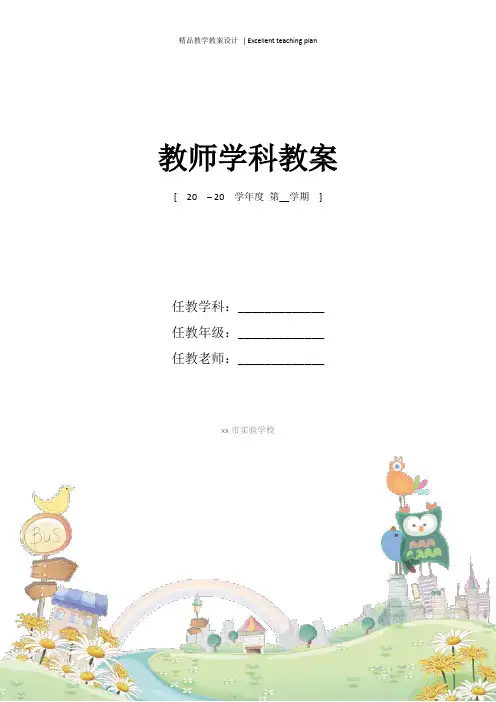
教师学科教案[ 20 – 20 学年度第__学期]任教学科:_____________任教年级:_____________任教老师:_____________xx市实验学校人教新版四年级英语下册Unit 4 There are seven days in a weekLesson 20教学设计教学目标:1. 本课继续第19课的话题,以歌谣的形式呈现学习内容。
2. 听说认读单词:Monday和Tuesday,书写Monday 和Tuesday 两个四会单词。
掌握以下语句When do you have PE lessons? We have PE lessons on Monday and Tuesday.3. 通过做游戏,加深对一周七天的英语表达的理解掌握。
教学重点:听说认读单词:today,Monday和Tuesday,书写today 和Monday两个四会单词。
教学难点:掌握以下语句When do you have PE lessons? We have PE lessons on Monday and Tuesday.课前准备1. 单词卡片、教学挂图、录音带。
教学过程1. 设情导入(Warm-up/Revision)师生一起Let’s chant,In a week, in a week. There are seven days. Sunday, Sunday, it’s the firstday. Sunday, Sunday, Let’s go and play.巩固上节课所学的重点词汇,大家一起边唱边表演。
使学生在欢快的节奏中感受、体验学习的乐趣。
2. 设趣导学(Presentation)1) 教师问学生:How many days are there in a week?What are there? What day is today? 引导学生根据实际情况回答问题。
2)教师用—周7天的课件图片带领学生一起学习、复习星期的说法。
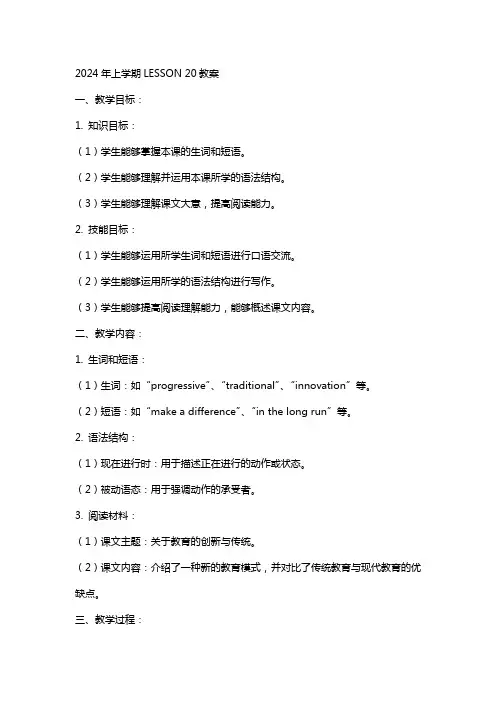
2024年上学期LESSON 20教案一、教学目标:1. 知识目标:(1)学生能够掌握本课的生词和短语。
(2)学生能够理解并运用本课所学的语法结构。
(3)学生能够理解课文大意,提高阅读能力。
2. 技能目标:(1)学生能够运用所学生词和短语进行口语交流。
(2)学生能够运用所学的语法结构进行写作。
(3)学生能够提高阅读理解能力,能够概述课文内容。
二、教学内容:1. 生词和短语:(1)生词:如“progressive”、“traditional”、“innovation”等。
(2)短语:如“make a difference”、“in the long run”等。
2. 语法结构:(1)现在进行时:用于描述正在进行的动作或状态。
(2)被动语态:用于强调动作的承受者。
3. 阅读材料:(1)课文主题:关于教育的创新与传统。
(2)课文内容:介绍了一种新的教育模式,并对比了传统教育与现代教育的优缺点。
三、教学过程:1. 热身(5分钟):(1)学生自由交谈,谈论自己对教育的看法。
(2)老师引导学生谈论教育的创新与传统。
2. 课堂讲解(15分钟):(1)老师讲解本课的生词和短语。
(2)老师讲解现在进行时和被动语态的用法。
3. 小组讨论(15分钟):(1)学生分成小组,阅读课文。
(2)学生讨论课文内容,理解教育的创新与传统。
4. 实践活动(15分钟):(1)学生进行角色扮演,模拟教育创新与传统的场景。
(2)学生用所学生词和短语进行口语交流。
(2)学生回家作业,包括抄写生词、短语和练习语法结构。
四、教学评价:1. 课堂参与度:观察学生在课堂上的发言和互动情况。
2. 口语表达:评估学生在角色扮演中的口语表达能力。
3. 阅读理解:检查学生对课文内容的理解程度。
4. 作业完成情况:检查学生回家作业的完成质量。
五、教学资源:1. 课文文本:提供关于教育创新与传统的文章。
2. 生词和短语卡片:用于课堂讲解和实践活动。
3. 角色扮演道具:用于模拟教育创新与传统的场景。
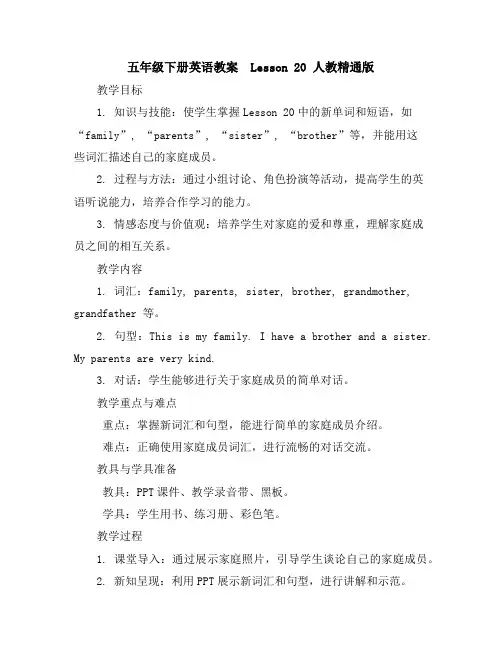
五年级下册英语教案 Lesson 20 人教精通版教学目标1. 知识与技能:使学生掌握Lesson 20中的新单词和短语,如“family”, “parents”, “sister”, “brother”等,并能用这些词汇描述自己的家庭成员。
2. 过程与方法:通过小组讨论、角色扮演等活动,提高学生的英语听说能力,培养合作学习的能力。
3. 情感态度与价值观:培养学生对家庭的爱和尊重,理解家庭成员之间的相互关系。
教学内容1. 词汇:family, parents, sister, brother, grandmother, grandfather 等。
2. 句型:This is my family. I have a brother and a sister. My parents are very kind.3. 对话:学生能够进行关于家庭成员的简单对话。
教学重点与难点重点:掌握新词汇和句型,能进行简单的家庭成员介绍。
难点:正确使用家庭成员词汇,进行流畅的对话交流。
教具与学具准备教具:PPT课件、教学录音带、黑板。
学具:学生用书、练习册、彩色笔。
教学过程1. 课堂导入:通过展示家庭照片,引导学生谈论自己的家庭成员。
2. 新知呈现:利用PPT展示新词汇和句型,进行讲解和示范。
3. 小组活动:学生分组,用新学词汇和句型介绍自己的家庭成员。
4. 角色扮演:学生扮演家庭成员,进行对话练习。
板书设计新词汇:family, parents, sister, brother, grandmother, grandfather 等。
句型:This is my family. I have a brother and a sister. My parents are very kind.家庭成员关系图。
作业设计1. 书面作业:完成练习册中有关家庭成员的练习题。
2. 口头作业:向家长用英语介绍自己的家庭成员。
课后反思反思学生对新词汇和句型的掌握程度。
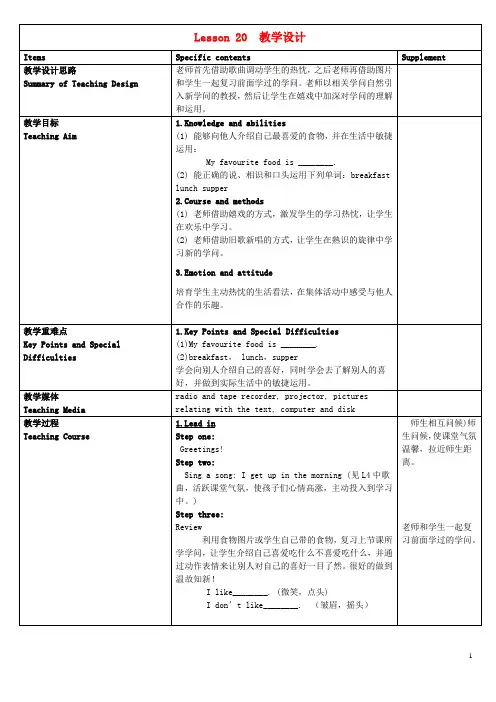
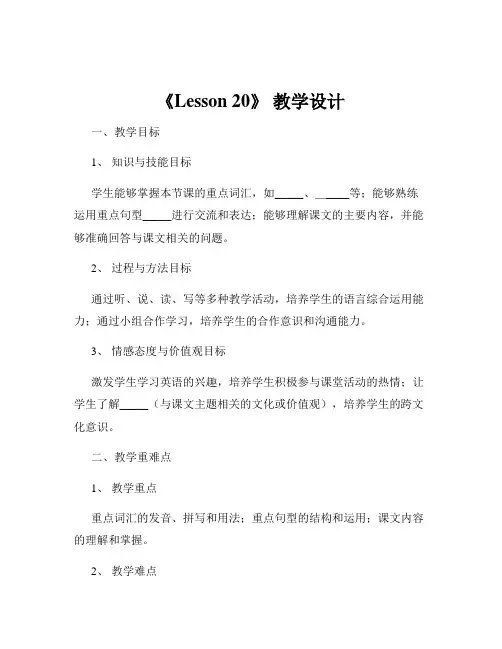
《Lesson 20》教学设计一、教学目标1、知识与技能目标学生能够掌握本节课的重点词汇,如_____、_____等;能够熟练运用重点句型_____进行交流和表达;能够理解课文的主要内容,并能够准确回答与课文相关的问题。
2、过程与方法目标通过听、说、读、写等多种教学活动,培养学生的语言综合运用能力;通过小组合作学习,培养学生的合作意识和沟通能力。
3、情感态度与价值观目标激发学生学习英语的兴趣,培养学生积极参与课堂活动的热情;让学生了解_____(与课文主题相关的文化或价值观),培养学生的跨文化意识。
二、教学重难点1、教学重点重点词汇的发音、拼写和用法;重点句型的结构和运用;课文内容的理解和掌握。
2、教学难点如何让学生在实际情境中灵活运用所学的词汇和句型;如何引导学生理解课文中的一些复杂句子和语法结构。
三、教学方法讲授法、操练法、讨论法、情景教学法。
四、教学过程1、导入(5 分钟)通过播放一段与本节课主题相关的英语视频或展示一些图片,引起学生的兴趣,从而导入新课。
例如,如果本节课的主题是“旅游”,可以展示一些美丽的旅游景点图片,然后问学生:“Have you ever been to these places?”引导学生用英语进行简单的交流和讨论。
2、词汇学习(10 分钟)教师呈现本节课的重点词汇,如_____、_____等,通过领读、讲解、举例等方式,让学生掌握词汇的发音、拼写和用法。
然后,让学生进行词汇操练,可以通过单词接龙、猜单词等游戏,巩固所学词汇。
3、句型学习(10 分钟)教师呈现重点句型_____,讲解句型的结构和用法,并给出一些例句。
然后,让学生模仿例句进行造句练习,教师进行巡视和指导,及时纠正学生的错误。
4、课文学习(15 分钟)教师播放课文录音,让学生边听边理解课文的大意。
然后,教师逐句讲解课文,帮助学生理解课文中的重点单词、短语和句子。
讲解完课文后,让学生再次听录音,模仿录音的语音、语调朗读课文。
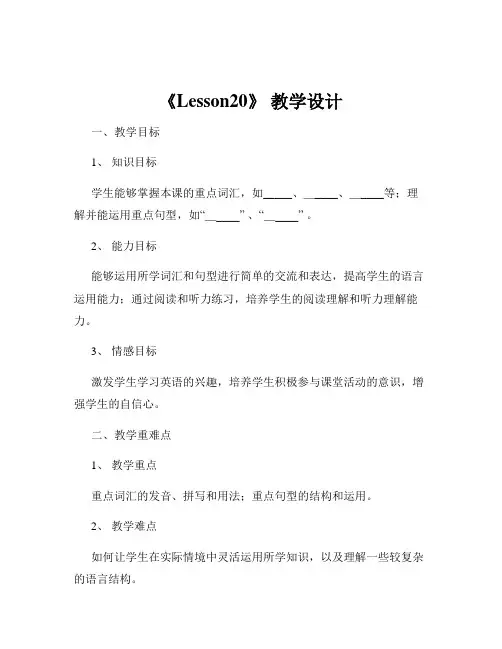
《Lesson20》教学设计一、教学目标1、知识目标学生能够掌握本课的重点词汇,如_____、_____、_____等;理解并能运用重点句型,如“_____” 、“_____” 。
2、能力目标能够运用所学词汇和句型进行简单的交流和表达,提高学生的语言运用能力;通过阅读和听力练习,培养学生的阅读理解和听力理解能力。
3、情感目标激发学生学习英语的兴趣,培养学生积极参与课堂活动的意识,增强学生的自信心。
二、教学重难点1、教学重点重点词汇的发音、拼写和用法;重点句型的结构和运用。
2、教学难点如何让学生在实际情境中灵活运用所学知识,以及理解一些较复杂的语言结构。
三、教学方法1、情景教学法通过创设生动的情景,让学生在实际情境中感受和运用语言。
2、任务驱动法布置各种任务,让学生在完成任务的过程中提高语言能力。
3、互动教学法鼓励学生积极参与课堂互动,如小组讨论、角色扮演等。
四、教学过程1、导入(5 分钟)通过播放一段与本课主题相关的英语视频或展示一些图片,引起学生的兴趣,导入新课。
提问学生关于视频或图片的内容,引导学生用英语回答。
2、词汇学习(10 分钟)展示本课的重点词汇,讲解其发音、拼写和用法。
可以通过举例、造句等方式帮助学生理解。
让学生跟读词汇,进行多次重复练习,确保发音准确。
3、句型学习(10 分钟)呈现重点句型,解释其结构和意义。
通过例句让学生体会句型的用法。
引导学生模仿例句进行造句练习,教师给予及时的反馈和纠正。
4、听力练习(10 分钟)播放课文的听力材料,让学生认真听。
听完后,设置一些与听力内容相关的问题,让学生回答,检查学生的听力理解情况。
5、阅读练习(10 分钟)让学生阅读课文,理解课文的大意。
然后,针对课文内容提出一些问题,让学生回答,加深对课文的理解。
6、小组讨论(10 分钟)组织学生进行小组讨论,讨论的话题与课文内容相关。
鼓励学生运用所学的词汇和句型表达自己的观点和想法。
每个小组选一名代表进行发言,其他小组可以进行补充和评价。
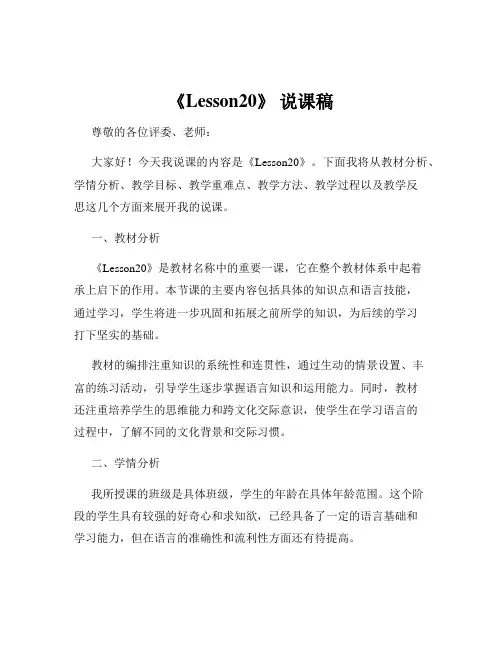
《Lesson20》说课稿尊敬的各位评委、老师:大家好!今天我说课的内容是《Lesson20》。
下面我将从教材分析、学情分析、教学目标、教学重难点、教学方法、教学过程以及教学反思这几个方面来展开我的说课。
一、教材分析《Lesson20》是教材名称中的重要一课,它在整个教材体系中起着承上启下的作用。
本节课的主要内容包括具体的知识点和语言技能,通过学习,学生将进一步巩固和拓展之前所学的知识,为后续的学习打下坚实的基础。
教材的编排注重知识的系统性和连贯性,通过生动的情景设置、丰富的练习活动,引导学生逐步掌握语言知识和运用能力。
同时,教材还注重培养学生的思维能力和跨文化交际意识,使学生在学习语言的过程中,了解不同的文化背景和交际习惯。
二、学情分析我所授课的班级是具体班级,学生的年龄在具体年龄范围。
这个阶段的学生具有较强的好奇心和求知欲,已经具备了一定的语言基础和学习能力,但在语言的准确性和流利性方面还有待提高。
大部分学生对英语学习有较高的兴趣,但在学习方法和自主学习能力方面还需要进一步的引导和培养。
此外,学生的个体差异较大,需要在教学中关注不同层次学生的需求,采取分层教学和个别辅导的方式,确保每个学生都能在课堂上有所收获。
三、教学目标基于对教材和学情的分析,我制定了以下教学目标:1、知识目标学生能够掌握本节课的重点单词和短语,如列举重点单词和短语。
学生能够理解并正确运用本节课的重点句型,如列举重点句型。
2、技能目标能够听懂与本节课主题相关的听力材料,并获取关键信息。
能够运用所学的语言知识进行口头表达和书面表达,描述与主题相关的内容。
3、情感目标培养学生学习英语的兴趣和积极性,增强自信心。
引导学生了解不同文化之间的差异,培养跨文化交际意识。
四、教学重难点1、教学重点重点单词和短语的记忆和运用。
重点句型的理解和熟练运用。
2、教学难点如何引导学生在实际情境中灵活运用所学的语言知识进行交流。
帮助学生克服语言表达中的错误,提高语言的准确性和流利性。
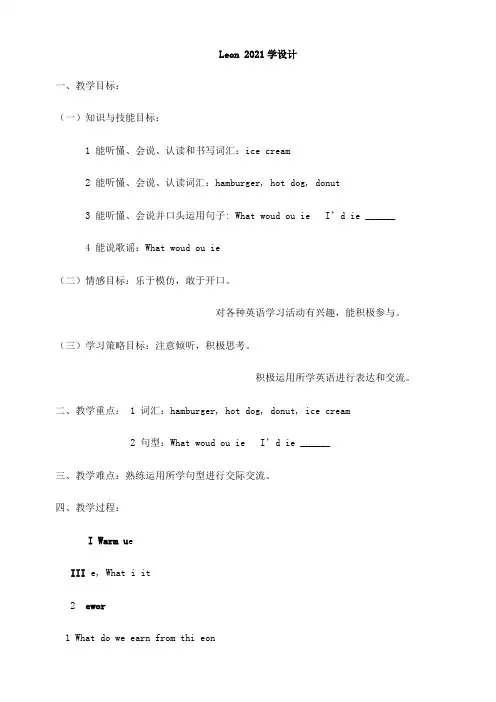
Leon 2021学设计
一、教学目标:
(一)知识与技能目标:
1 能听懂、会说、认读和书写词汇:ice cream
2 能听懂、会说、认读词汇:hamburger, hot dog, donut
3 能听懂、会说并口头运用句子: What woud ou ie I’d ie ______
4 能说歌谣:What woud ou ie
(二)情感目标:乐于模仿,敢于开口。
对各种英语学习活动有兴趣,能积极参与。
(三)学习策略目标:注意倾听,积极思考。
积极运用所学英语进行表达和交流。
二、教学重点: 1 词汇:hamburger, hot dog, donut, ice cream
2 句型:What woud ou ie I’d ie ______
三、教学难点:熟练运用所学句型进行交际交流。
四、教学过程:
I Warm u e
III e, What i it
2 ewor
1 What do we earn from thi eon
2 Do ou have an quetion
3 homewor: Read the tet
Write the word
Do the eercie
板书设计:
Leon 2021Hamburger and Hot Dog
hamburger
What woud ou ie hot dog
I’d ie donut
ice cream。
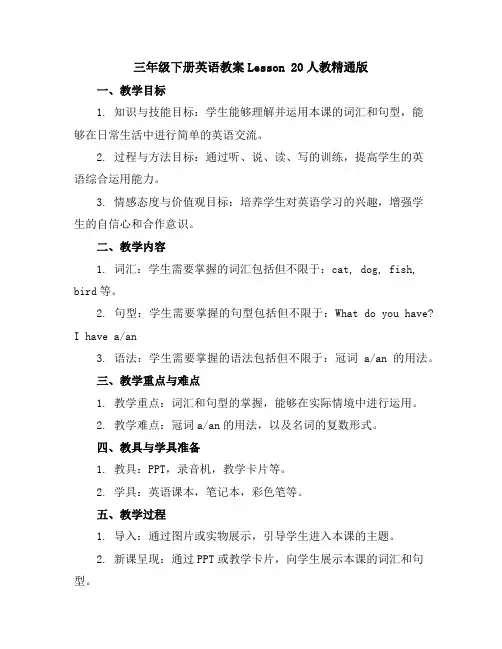
三年级下册英语教案Lesson 20人教精通版一、教学目标1. 知识与技能目标:学生能够理解并运用本课的词汇和句型,能够在日常生活中进行简单的英语交流。
2. 过程与方法目标:通过听、说、读、写的训练,提高学生的英语综合运用能力。
3. 情感态度与价值观目标:培养学生对英语学习的兴趣,增强学生的自信心和合作意识。
二、教学内容1. 词汇:学生需要掌握的词汇包括但不限于:cat, dog, fish, bird等。
2. 句型:学生需要掌握的句型包括但不限于:What do you have?I have a/an3. 语法:学生需要掌握的语法包括但不限于:冠词a/an的用法。
三、教学重点与难点1. 教学重点:词汇和句型的掌握,能够在实际情境中进行运用。
2. 教学难点:冠词a/an的用法,以及名词的复数形式。
四、教具与学具准备1. 教具:PPT,录音机,教学卡片等。
2. 学具:英语课本,笔记本,彩色笔等。
五、教学过程1. 导入:通过图片或实物展示,引导学生进入本课的主题。
2. 新课呈现:通过PPT或教学卡片,向学生展示本课的词汇和句型。
3. 练习:通过听录音,朗读,角色扮演等方式,让学生练习本课的词汇和句型。
4. 巩固:通过游戏,竞赛等方式,巩固学生对本课知识点的掌握。
六、板书设计1. 课题:Lesson 202. 词汇:cat, dog, fish, bird等。
3. 句型:What do you have? I have a/an4. 语法:冠词a/an的用法,名词的复数形式。
七、作业设计1. 听力练习:听录音,完成相应的练习。
2. 口语练习:和家人或朋友用英语进行交流,使用本课的句型。
3. 写作练习:写一篇小短文,描述自己喜欢的小动物。
八、课后反思1. 教学内容是否清晰,学生是否能够理解和掌握。
2. 教学方法是否合适,是否能够激发学生的学习兴趣。
3. 教学效果如何,是否达到预期的教学目标。
4. 对学生的反馈是否及时,对学生的指导是否到位。
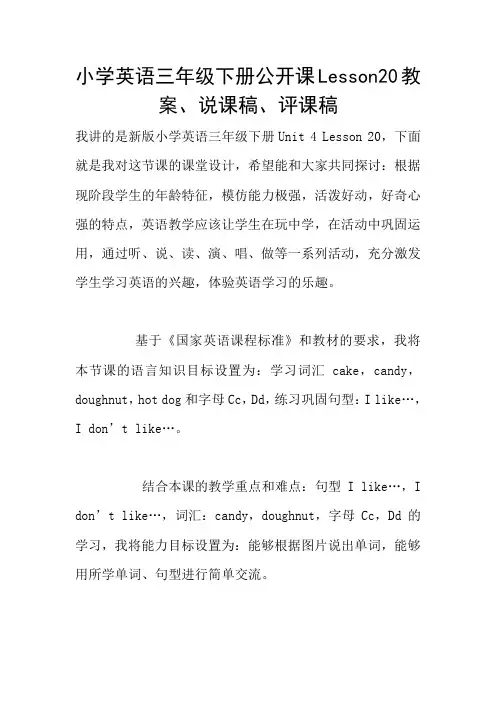
小学英语三年级下册公开课Lesson20教案、说课稿、评课稿我讲的是新版小学英语三年级下册Unit 4 Lesson 20,下面就是我对这节课的课堂设计,希望能和大家共同探讨:根据现阶段学生的年龄特征,模仿能力极强,活泼好动,好奇心强的特点,英语教学应该让学生在玩中学,在活动中巩固运用,通过听、说、读、演、唱、做等一系列活动,充分激发学生学习英语的兴趣,体验英语学习的乐趣。
基于《国家英语课程标准》和教材的要求,我将本节课的语言知识目标设置为:学习词汇cake,candy,doughnut,hot dog和字母Cc,Dd,练习巩固句型:I like…,I don’t like…。
结合本课的教学重点和难点:句型I like…,I don’t like…,词汇:candy,doughnut,字母Cc,Dd的学习,我将能力目标设置为:能够根据图片说出单词,能够用所学单词、句型进行简单交流。
根据小学生的学习特点和心理需求,我将本节课的情感目标确定为:培养学生自主学习能力和合作精神,使他们能够乐于模仿,敢于开口,积极参与,体验集体合作的成就感。
本节课的整个教学过程采用的是任务型教学模式,以“争做热情的小主人”这一小组任务,作为活动主线,在小组活动的过程中,体验集体学习的乐趣,感受合作的默契,在教师的指导下,通过感知、体验、实践、参与和合作等方式,实现任务目标,感受成功,提高学生的自主学习能力,在完成教学任务的同时,促进了学生情感态度和学习策略的形成。
本节课在以任务型教学模式贯穿始终的同时,还运用了愉快教学法、情景教学法、活动教学法等,使学生在教师的引导下,在轻松、愉悦的氛围中学习教学内容,使他们体验到学习英语的快乐。
在教学环节的安排上,第一步是复习热身。
节奏感极强的韵句,既复习了旧知,又使学生迅速进入英语学习状态,营造愉快、和谐的学习氛围。
然后教师渗透任务。
在这里强调的是:有关字母A和B的chant是我们上节课的学习内容,此韵句的使用不仅突出了学习的重点,而且将枯燥的字母和单词的学习趣味化,也为本节课字母C和D以及有关单词的学习作了铺垫。
四年级下册英语教案 Lesson 20 人教精通版教学目标1. 知识与技能:学生能够理解并运用本课所学的单词和句型,如“library”, “borrow”, “return”等,进行简单的图书馆场景对话。
2. 过程与方法:通过小组合作和角色扮演,培养学生运用英语进行实际交流的能力。
3. 情感态度与价值观:培养学生对英语学习的兴趣,增强合作意识,理解图书馆借阅的基本规则。
教学内容1. 单词:library, book, magazine, borrow, return, read。
2. 句型: Can I borrow this book? Yes, you can. Whereis the library? It's on the first floor.教学重点与难点重点:单词的正确发音和句型的实际应用。
难点:理解并正确使用“borrow”和“return”这两个动词。
教具与学具准备教具:多媒体课件,图书馆场景图片,单词卡片。
学具:学生自带英语课本,笔记本,彩色笔。
教学过程1. 课堂导入:通过展示图书馆的图片,引导学生猜测今天的话题。
2. 新知识学习:教授新单词和句型,通过游戏和练习加强记忆。
3. 小组活动:学生分组进行角色扮演,模拟图书馆借阅场景。
板书设计中心:Lesson 20 。
左侧:单词列表和图片。
右侧:句型示例和练习题。
作业设计1. 书面作业:完成课后练习题,巩固单词和句型。
2. 口头作业:与家长或同伴进行英语对话,模拟图书馆借阅场景。
课后反思教学效果:观察学生在小组活动和练习中的表现,评估他们对新知识的掌握程度。
改进措施:根据学生的反馈和学习效果,调整教学方法,增加更多互动环节,提高学生的参与度。
此教案旨在通过丰富的内容和严谨的用词,为学生提供一个全面而深入的学习体验,确保他们在理解新知识的同时,能够有效地运用英语进行实际交流。
通过教学过程中的互动和练习,培养学生对英语学习的兴趣和合作意识,同时加强他们对图书馆借阅规则的理解。
Unit 4 The Internet Connects Us lesson 20 A Computer Helps一、Teaching content:(教学内容)1. New words and phrases: laptop, Easter, enter, key, search, topic, depend, bunny, hide, search engine, de pend on, Easter Bunny, decide to do.2. Understand the meaning of text.3. Grammar: Adverbial Clause with “if”.二、Teaching goals:(教学目标)1. Master the new words and phrases, the meaning of text.2. Make the Ss talk about how to use a computer to learn.3. To learn more knowledge of the world, we should learn to use computer.三、Key points:(重点)Master the new words and phrases, the meaning of text.四、Difficult points:(难点)Make the Ss talk about how to use a computer to learn.五、Teaching aids:(教学辅助) Pictures or cards.六、Type of the less on:(课程类型) New lesson.七、Teaching procedure:(教学过程)Step 1. Analysis of the student.(学生分析)Homework check.Review: The Grammar-- Adverbial Clause with “if”.Ask some Ss to make sentences in “if”.In last lesson, we knew that what is computer, and we learned that we should learn to use the computer for learning. In this lesson, we will go on talking about the computer, and we must know computer how important to us.Step 2. Lead in.(引入)1.Greet the students in English and make sure they can response correctly.Do the duty report: a student on duty can say whatever he/she likes to say.2.Think About It:What do you know about Easter?Do you often search for information on the Internet? How?Step 3. New lesson.(新课)No. 1 Prepare lessons before class.Teach the new words and phrases. Make sure the Ss can read it correctly.No. 2. Text: Give them some time to read the text themselves. Then let them act out the dialo gue in groups. Correct their p ronunciation when necessary.At last, the teacher explains the text in Chinese; make sure the Ss can understand the meaning of text.No. 3. Important sentences:It is very helpful.I decided to do all of my research on the Internet.No. 4. Culture TipThe celebrate of Easter is all about new life. Christians celebrate new life at Easter. Though the meaning of East er has changed o ver time, the rabbits and eggs remain. Children use baskets to collect colored eggs when they go hunting for Easter eggs. No. 5. Finish “Let’s Do It!”Step 4. Listen to the text.Make the Ss listen to the text, then l et them read follow the material.St ep 5. Summary. (小结)Sum up the text what we learned, the new words, phrases, and sentences.Sum up the grammar.Step 6. Homework.(作业)Finish the activity book and the practice.Copy the new words and phrases twice.Ste p 7. Blackboard-writing:(板书)The new words, the master phrases, important sentences.The grammar and practice.八.Teaching reflection:(教后反思)。
教学课题Lesson 20主备教师使用教师授课时间教学目标知识与技能学会月份及节日的表达法。
过程与方法To teach the Ss how to say the first month to second month of the year.情感态度与价值观To promote Ss’interest and confidence.教学重点January is the first month of the year.February is the second month of the year.教学难点Spring Festival is usually in January or February. They go back home to celebrate the festival with their families.教法与学法Communication Teaching Method. Direct Teaching Method. Reading and drawing.TPR.教学准备及手段准备反映1~2月特征及相关节日特征的图片、照片。
教学流程二次备课Step 1.Revision1.热身/ 复习(Warming-up / Revision)1)教师播放Happy New Year! 音乐(不含歌词),让学生猜一猜是什么歌曲。
猜中后,教师与大家一起唱。
2)复习一周七天的英语单词。
Step2.Presentation.1)播放欢快喜庆的音乐,教师拿着日历提问:How many days arethere in a week? There are seven days in a week.They are Monday, Tuesday ....What’s the first day of the week? Howmany days are there in a year? There are 365 days in a year.2)教师拿着一个月的日历,问学生:But do you know how manymonths are there in a year? 借助日历让学生理解month的含义。